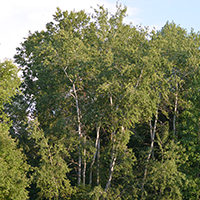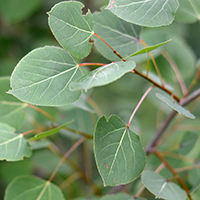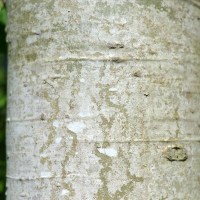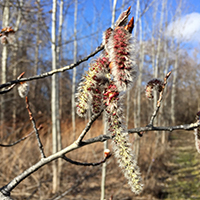What trembling aspen looks like
Size and shape
- Medium-large tree.
- Reaches 25 metres high.
Leaves
- Leaf stalk is flattened and longer than the leaf blade.
- Leaves are wide with a pointed tip.
- The slightest breeze causes leaves to “tremble.”
Bark
- Young bark is smooth, pale greyish-white with horizontal lines.
- Bark grows dark and furrowed with age.
Flowers
- Fluffy seeds are dispersed from hanging green capsules in late spring.
Where trembling aspen is found
Trembling aspen is similar in its range to its cousin, balsam poplar, covering all of Ontario except the most northern fringe near Hudson Bay. It occurs throughout all forested areas of Canada.
What you need to know to grow trembling aspen
- Moisture: adaptable to all but the wettest sites.
- Soil: adaptable to most soil types.
- Shade: intolerant of shade, prefers full sun.
- Caution: trembling aspen is a remarkable species for quick growth and establishment on nutrient poor, disturbed or burnt areas, but is not recommended for most residential situations as it develops a large root system from which new trees can sprout and has weak wood, making it a safety hazard.
Benefits and uses of trembling aspen
Wildlife benefits
Trembling aspen provides shade and a food source for deer, moose and other wildlife. Ruffed grouse and other bird species nest in trembling aspen.
Commercial uses
Wood from trembling aspen is used for:
- pulp
- chipboard
- matches and clothespins
- boxes, crates and pallets
- veneer
Current research
To learn about our research on trembling aspen, visit our science publications catalogue and search for “trembling aspen”.
Fun facts about trembling aspen
- It can form expansive colonies by sending up new stems as an old stem dies. One colony in Utah is estimated to be over 80,000 years old.
- It often grows in pure stands after disturbance but will eventually be outgrown by conifers or other hardwoods.
Updated: January 10, 2024
Published: July 18, 2014



